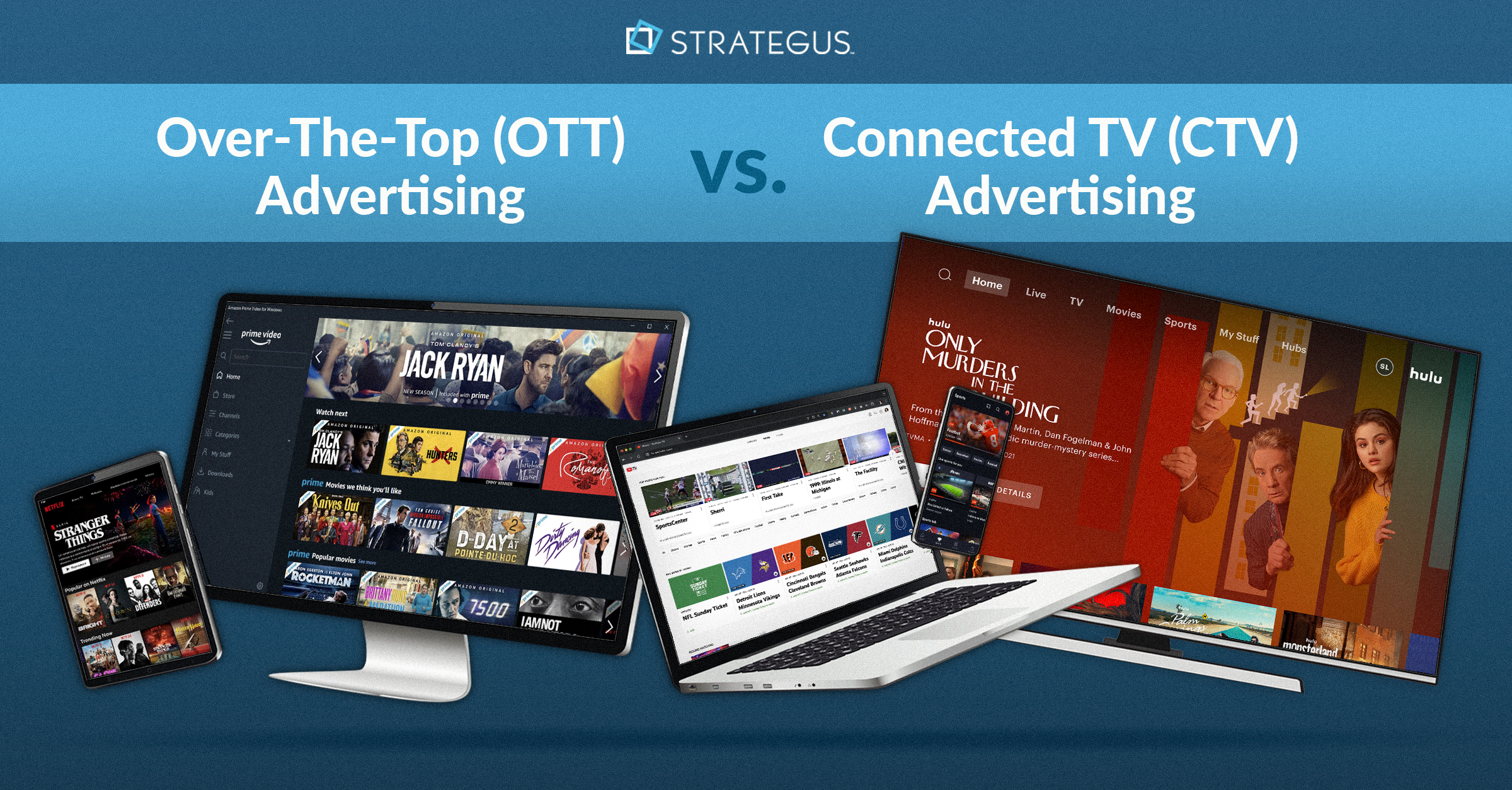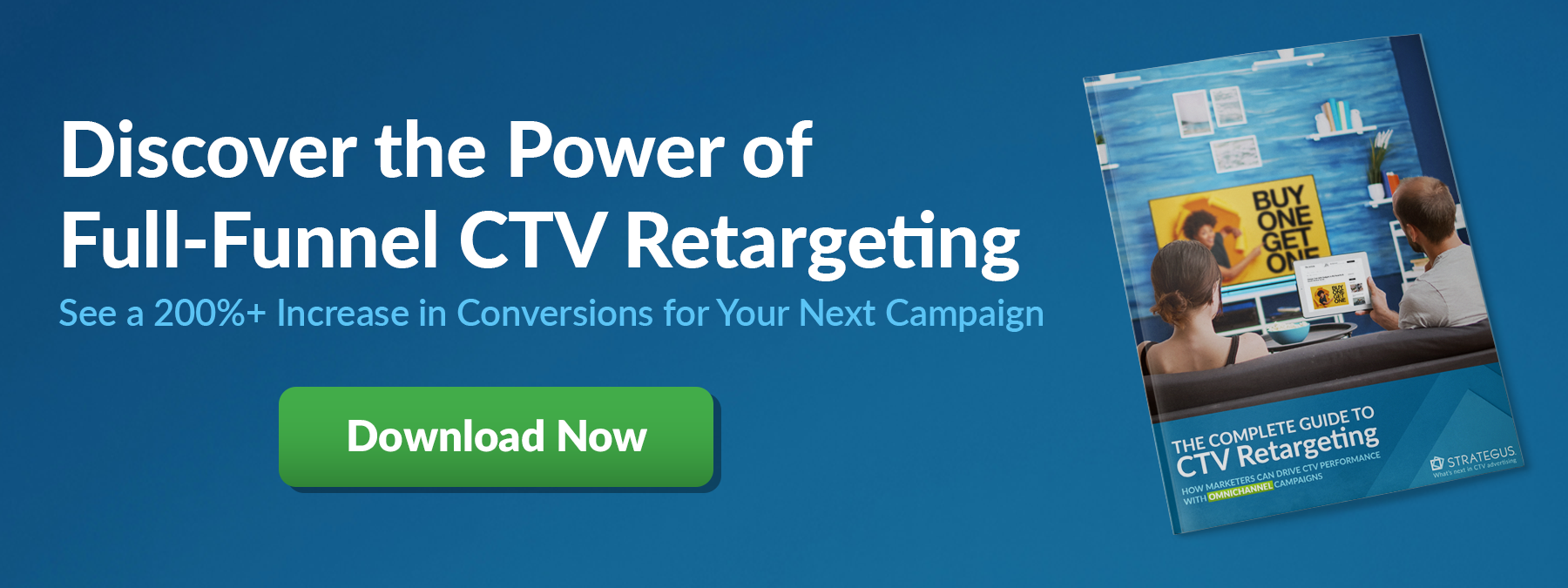- Home
- Strategus Blog
- OTT vs. CTV Advertising: What’s the Difference & Examples
OTT vs. CTV Advertising: What’s the Difference & Examples
 Traci Ruether
Traci Ruether
11 minutes read

The terms connected TV (CTV) and over-the-top (OTT) are often used interchangeably — but media buyers need to understand the subtle distinctions when evaluating ad placements. Why? It all comes down to understanding what you’re buying.
While all CTV content is delivered over the top, only a small, premium segment of OTT content is viewed on connected TV devices.
This is because the central idea of each term is quite different:
- OTT refers to the delivery method, specifically, streaming video over the internet.
- CTV, on the other hand, refers to the big-screen TV devices used to access OTT content (such as smart TVs, streaming devices like Roku, and gaming devices like Xbox).
As such, a true CTV advertising campaign should start with the living room TV rather than a smartphone or tablet used to stream Amazon Prime on the go.
After all, viewers are more engaged when watching content on the household television, which maximizes brand recall through immersive sight, sound, and motion. We also know that co-viewing is more common when watching TV sets, allowing for shared experiences that can amplify an ad’s impact.

This isn’t to say that OTT advertising at large isn’t valuable. But if you’re being sold premium CTV placements, you’ll want to probe a little further to ensure that you’re getting what your paying for.
In this blog, we’ll look at examples and benefits of CTV and OTT advertising — providing tips on how to combine the two to maximize reach and impact.
What Is Over the Top (OTT)?

OTT describes all streaming media content that’s delivered to viewers using the internet rather than a traditional satellite or cable network.
Top players in the OTT space include Netflix, Disney+, Amazon Prime, Hulu, YouTubeTV, PlutoTV, and Sling. Internet radio and VoIP services like WhatsApp also count as OTT because they bypass traditional broadcasting alternatives — but for this article, we’ll be focusing on video streaming platforms.
What Is Over-the-Top Advertising?
OTT advertising refers to the video ads that play on OTT services like Amazon Prime. These can take a few different forms:
- Pre-roll video ads that play before a stream starts on someone’s tablet.
- Mid-roll video ads that pop up in the middle of viewing a show on Hulu at home.
- Banner ads that appear as a static graphic overlay during a YouTube video.
- The list goes on.
Because these ads are delivered digitally, they have many advantages over traditional TV advertising. Audience targeting and detailed performance measurement both give OTT advertising a significant edge.
That said, we’ve all flipped to another tab and muted our laptop during a commercial break. And I pushed the ‘skip’ button 5 seconds into a YouTube pre-roll right before starting this article.
This is just one reason why OTT ads delivered to personal devices are not the same as CTV ads that play on the biggest screen in the house.
What Is Connected TV (CTV)?

Connected TV refers to any internet-connected television used to stream video content on streaming services. Some common CTV devices include:
- Smart TVs like the Samsung OLED, which come with an operating system and preloaded apps.
- Streaming devices and set-top boxes like Amazon Fire that transform ‘dumb’ TVs into internet-connected devices that can access streaming content.
- Gaming consoles like the PlayStation that allow users to stream movies, TV shows, and music in addition to playing video games.
What Is Connected TV Advertising?
CTV advertising describes the video ads served to viewers using connected TVs to stream their favorite movies and shows. The benefits of CTV as compared to traditional TV advertising all tie back to data. Namely, when placing ads in these digital environments, marketers gain access to deep insight about the users they’re targeting and the actions viewers take following exposure.
This allows for much more data-driven tactics, including:
- Precise targeting: Reach specific demographics, interests, and viewing habits.
- Content-agnostic placement: Find your audience, no matter what they’re tuning into, by placing ads programmatically across a vast array of publishers.
- Real-time measurement: Track ad impressions, clicks, and conversions in real time.
- Retargeting: Re-engage viewers who have previously interacted with your brand online.
- Holistic attribution: Gain a comprehensive understanding of how your CTV campaigns contribute to overall marketing goals.
OTT Advertising vs. CTV Advertising
We’ve established how OTT and CTV advertising allow for more advanced tactics than running ads on your grandma’s cable box.

But what about how the two digital categories compare (OTT and CTV) in terms of ad performance? Does it all just come down to the devices that these ads are viewed on? And, if so, is a video ad on the living room TV really that different from one that plays on your smartphone?
In a word: yes.
CTV ads make up a select tier of OTT ads that are only delivered to big-screen TVs.
This means that co-viewing is more common (resulting in more ad impressions), viewers are more engaged (resulting in better recall), and the impact is much higher (resulting in actual business results).
In other words, CTV is the creme de la creme of OTT, promising:
- Better ad recall: CTV ads stay top of mind because they’re watched by tuned-in audiences, on the big screen, in the comfort of their own homes.
- Happy viewers: With CTV, advertisers can reach relaxed viewers that tolerate ads better than when on their mobile devices (probably because they’re watching the shows they love).
- Premium content: CTV is restricted to premium, long-form, professionally produced content on the networks we all know and trust.
- High completion rates: Unlike OTT ads on YouTube and the like, CTV ads can’t be skipped (making for nearly 100% video completion rates).
Need to get further into the minutiae? Here’s a side-by-side of the two.
|
Over-the-Top (OTT)
|
Connected TV (CTV)
|
|
|
Definition |
|
|
|
|
|
Big-screen devices like smart TVs, set-top boxes, gaming consoles. |
|
|
|
|
|
|
|
Advertisements served on TV screens during streaming content. |
|
|
|
|
|
Example |
|
|
Can Advertisers Combine CTV with Online Video OTT?
CTV advertising is great for exposing new households to your brand, educating local buyers about a current promotion, and re-engaging old contacts using first-party data. Just like traditional TV advertising, it’s the best way to catch your audience’s attention.
But you shouldn’t stop there. Because CTV ads are served in digital environments, it’s possible to design sophisticated retargeting campaigns that blend CTV with online video ads on YouTube and social media.
For example, after exposing someone to a brand on CTV, marketers can retarget them with ads on online video platforms that prompt additional engagement. This reinforces the message, moves viewers down the funnel, and drives conversions in a clickable environment.
And why stop there? Display ads, streaming audio, and other programmatic tactics can all be used to make CTV ads part of an omnichannel campaign.
When combining CTV with additional paid ads for more holistic campaigns, you’ll want to consider whether your goal is brand awareness or conversions. For awareness plays, aim for a 1:1 ratio of CTV ad exposures and retargeting. If you’re instead looking to drive clicks, phone calls, or form-fills, we’d suggest a ratio of 1:1.5 (meaning 1.5 retargeting impressions for every CTV ad exposure).
Why CTV Is the Future of TV Advertising
The average U.S. adult spends more than 123 minutes per day tuning into CTV. Ad-supported streaming has also become the norm, bringing more premium inventory for advertisers looking to reach engaged viewers on the biggest screen in the household.
Despite this, television advertising is currently divided into two distinct categories: traditional linear TV and CTV streaming. This has made advertising a juggling act, as media buyers struggle to allocate dollars across disparate environments. Add to this the consideration of OTT at large, including online video, streaming audio, and more — and media buying has become downright overwhelming.
Regardless, we’re moving towards a converged future, where all TV will be consumed digitally. And by embracing a viewer-centric approach that combines CTV ad exposure with omnichannel media across other channels, advertisers will do just fine.
Just make sure you know what you're purchasing, which is as simple as asking you're CTV ad provider questions like: “what percent of your CTV ads play on internet-connected TVs?” (Hint: the answer should be 100%)
Get Started With Strategus
At Strategus, we team up with brands and agencies to simplify CTV advertising and drive better performance. Our partner ecosystem integrates countless ad exchanges, SSPs, DSPs, publishers, and data providers to ensure precision targeting at scale. We take a hands-on approach — providing the expertise and resources needed to make the most out of your investment.
While we always start with CTV, that’s rarely the whole story. Instead, we combine big-screen CTV ads with retargeting across the programmatic ecosystem.
For instance, we might run ads for a law firm on their target viewers’ living room TV, and then re-engage these same viewers with additional online video, display, and/or streaming audio ads.
This gives brands and agencies a way to deliver the best message at each touchpoint, and create cohesive omnichannel experiences that increase engagement and drive conversions.
Are you interested in learning more? Reach out today.

Traci Ruether is a content marketing consultant specializing in video tech. With over a decade of experience leading content strategy, she takes a metrics-driven approach to storytelling that drives traffic to her clients' websites. Follow her on LinkedIn or learn more at traciruether.com.
Strategus is a managed services connected TV(CTV) advertising agency with over 60,000+ campaigns delivered. Find out how our experts can extend your team and drive the result that matter most.
Talk to an Expert
Table of Contents
Seeking a Custom CTV Strategy That Delivers?
What to read next

Third-Party Data Targeting for CTV: Benefits & Tactics
Third-party data. It’s a term that’s thrown around, and yet few take the time to detail its pros and cons — much less strategies for using...
7 minutes read

First-Party Data Targeting: Benefits and Tactics for CTV Advertising
First-party data is the information that companies collect directly from their customers rather than through intermediaries. Advertisers use this...
10 minutes read

Foot-Traffic Attribution: Tying Ad Impressions to In-Store Visits
The marketing funnel has changed. Today’s shoppers often begin researching products from the comfort of their homes and don’t set foot into a store...
8 minutes read

CTV Attribution: What It Is and How It Works
Connected TV (CTV) viewing is on the rise — and that’s good news for marketers. Not only can CTV ads be precisely targeted to individual households,...
9 minutes read

















